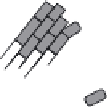Environmental Engineering Reference
In-Depth Information
parameters) whose general mechanics can supply solutions that are precise or
approximate in an explicit way [DES 98].
The goal of this chapter is to follow the fall of a boulder from the origin of its
departure from a cliff until it stops on the ground or against a protective structure
(see Figure 4.1) by analyzing the elementary events that it is subjected to at a
geomechanical level.
An assessment of the capacity of protective structures to absorb the energy of the
boulders is also presented.
Figure 4.1.
Fall trajectory of a boulder
4.2. Cliff stability and toppling
The instabilities of rock cliffs are generally predefined by the surfaces of
discontinuity of the mass intersecting the topography [DES 88, HOE 81]. Figure 4.2
schematically describes failure modes in relation to the orientation and inclination of
the discontinuities. Mode a
corresponds to an intense disorganized fracturing
without an identifiable preferred structure, which makes it similar to a slide of
unconsolidated strata. Modes b
and c
express a slide over one or more planes of
discontinuities, mode b
being a specific case of mode c
.





